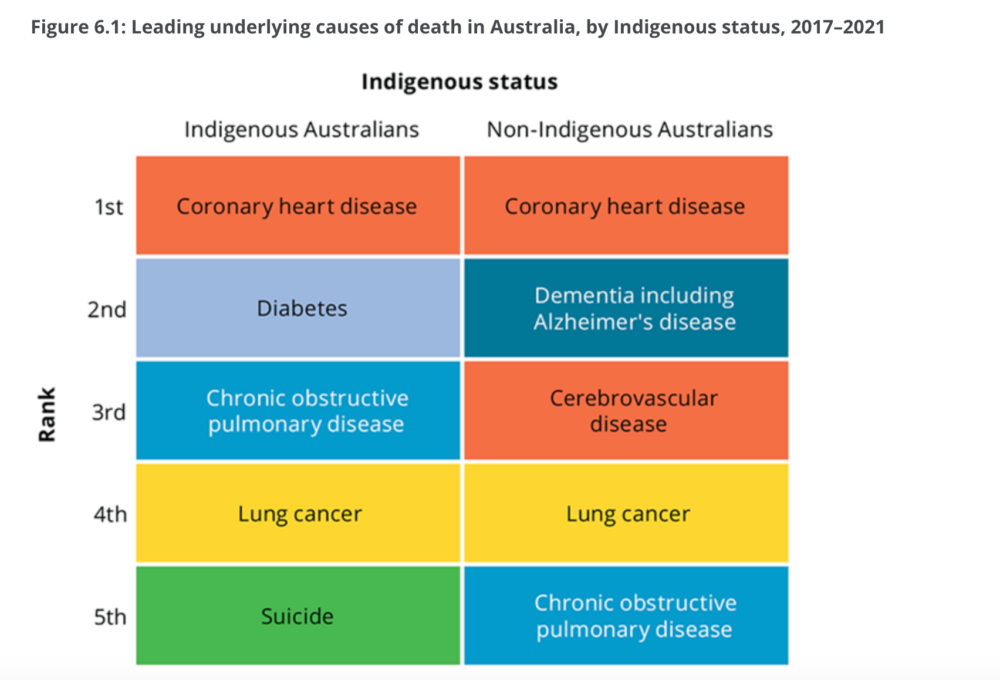
Acute Rheumatic Fever (ARF) still causes death in Indigenous Australians, who also have a higher risk of general heart disease death.
And currently only one in five people who need treatment for the Rheumatic Heart Disease that results from ARF can get this, according to a Flinders University study.
Between 2015–2019, ninety-five per cent of the 2128 cases of Acute Rheumatic Fever notifications were recorded among Indigenous Australians, says the Australian Institute of Health and Welfare. And even this figure is likely to be under-reported.
Australian Indigenous males and females had heart failure and cardiomyopathy death rates 2.2 and 2.6 times as high as Australian non-Indigenous males and females, in 2020-2021, says the Australian Institute of Health and Welfare.
And hospitalisation for heart failure or cardiomyopathy among Indigenous Australians was 2.9 times as high as the non-Indigenous rate, in the same time period.
It’s important to know this as part of the truth-telling needed to inform closing the health gap between Indigenous and non-Indigenous Australians.
Acute Rheumatic Fever damages connective tissues.
Acute Rheumatic Fever damages connective tissues, especially in the heart. Those who’ve had it have a high chance their heart valves will become permanently damaged. This heart valve damage can follow an untreated or under-treated streptococcal infection such as strep throat or scarlet fever.
Stopping streptococcal infections in the first place can reduce Acute Rheumatic Fever and its related Rheumatic Heart Disease. This can be done with antibiotics.
This is particularly important because the incidence of Acute Rheumatic Fever and Rheumatic Heart Disease is not tapering off.
And managing these conditions should be an easy target for fixing.
So why are Indigenous Australians more vulnerable?
Because it’s more likely to occur where there is poverty, overcrowding and reduced access to medical care. These are three situations that Indigenous Australians are more likely to find themselves in. It’s a disease rarely seen in affluent communities. (Analysis by the AIHW of ABS survey data shows that about 34 per cent of the total health gap between Indigenous and non-Indigenous Australians is due to social determinants.)
Acute Rheumatic Fever is more prevalent in females. It often occurs between the ages of 5 and 14, leaving a lifetime to struggle with the consequent heart damage. Pregnant women with Rheumatic Heart Disease and their babies are particularly vulnerable to dying because of the added stress on the mother-to-be’s heart valves.
“It’) a serious problem, but one that can – and should – be rectified,” say Flinders University, South Australia, researchers, Associate Professor Amanda Müller and Kerissa Govender of the College of Nursing and Health Sciences.
They say the introduction of a national Rheumatic Heart Disease register would help. That way, more information about who needs help would get where it is needed more quickly. At the same time, this could deliver better pain management.
But the key to achieving a better outcome would be to involve Indigenous Australians in designing their own health care strategy for the disease. And then implementing the education about the disease too, say Associate Professors Müller and Kerissa Govender.
Looking at life expectancy more broadly.
In 2015–2017, the gap between Indigenous and non-Indigenous Australians life expectancy was estimated to be 8.6 years for males and 7.8 years for females. This was according to the https://www.indigenoushpf.gov.au/Report-overview/Overview/Summary-Report/References (ABS 2018b).
Today the figures aren’t any better.

Recent AIHW figures show the five leading causes of death for Indigenous Australians, between 2017-2021, in order were: coronary heart disease, diabetes, chronic obstructive pulmonary disease (COPD), lung cancer and suicide.
This compares to the five leading causes of death for other Australians in the same timeframe, which in order were: coronary heart disease, dementia including Alzheimer’s disease, cerebrovascular disease, lung cancer and pulmonary obstructive disease.
So there’s a lot more truth telling to be done. Followed by fixing.
Resources
The Flinders University College of Nursing and Health Sciences research is “Secondary Prophylaxis Among First Nations People with Acute Rheumatic Fever in Australia: An Integrative Review”, by Kerissa Govender and Amanda Müller. It has been published in the Journal of Transcultural Nursing, at: https://doi.org/10.1177/10436596231191248
For more about Acute Rheumatic Fever, go to: https://www.cdc.gov/groupastrep/diseases-public/rheumatic-fever.html
Read the Heart, stroke and vascular disease: Australian facts, web report, last updated, 30 Jun 2023 at: https://www.aihw.gov.au/reports/heart-stroke-vascular-diseases/hsvd-facts/contents/all-heart-stroke-and-vascular-disease/arf-and-rhd
See the Aboriginal and Torres Strait Islander Health Performance Framework – Summary report, lasted updated August 8, 2023, at: https://www.indigenoushpf.gov.au/report-overview/overview/summary-report?ext=.
Also, Acute rheumatic fever and rheumatic heart disease in Australia 2017-2021 Publication Release Date, 30 May 2023, at: https://www.aihw.gov.au/reports/indigenous-australians/arf-rhd/summary
To read about the historic impacts of colonisation in Australia, go to:
Read about the Red Dust Healing program, designed to support Indigenous Australians with unresolved grief.
